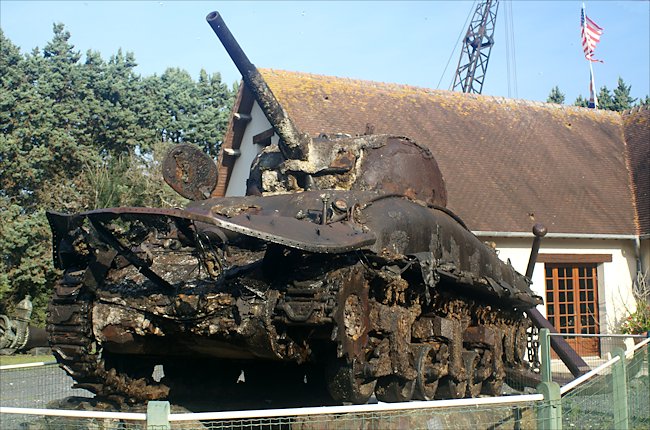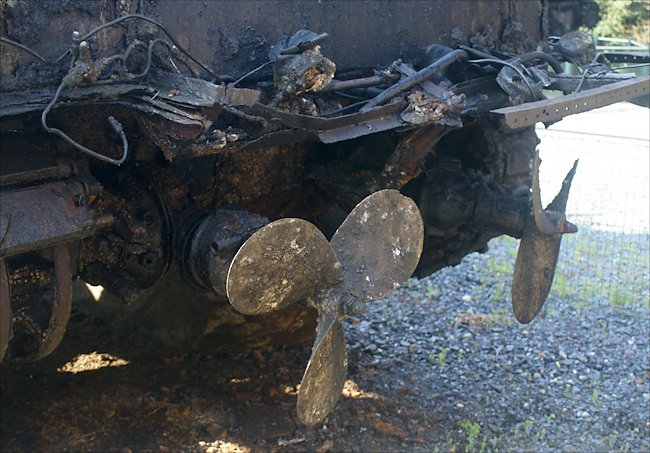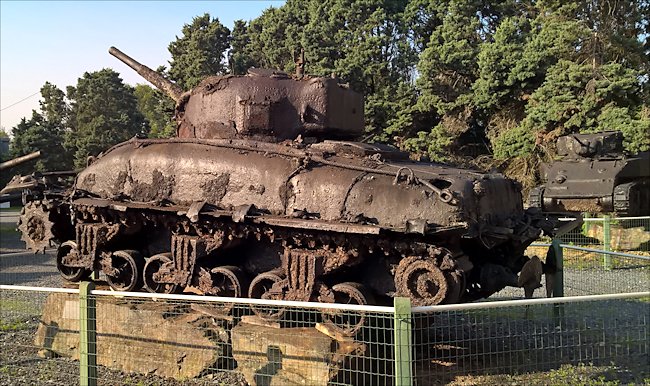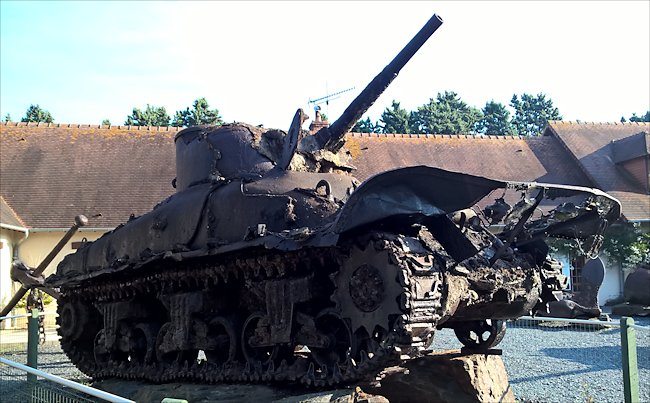Sherman M4A1(75) DD Tank Wreck
This version of the Sherman M4A1(75) DD tank has large hull hatches compared with the other Sherman M4A1(75) DD tank at the D-Day Underwater Wrecks Museum in Normandy that has small hatches.

You can still see the boat shaped metal 'skirt' at the front of this DD Sherman Tank underwater wreck
Location
This is the D-Day wrecks museum. It is situated on the D6 road from Bayeux to the charming Normandy costal village of Port-en-Bessin-Huppain. It is on the right as you pass the sign for the Chateaux La Cheneviere restaurant.
The complex grounds are screened by a wall of tall evergreen trees. Sticking above the tree tops is a crane and normally three flags; the French tricolour, British Union Jack and American Stars and stripes. Slow your car down as you pass the Chateaux as the museum entrance is very quickly upon you.
The Museum is open every day between 1st June to the 30th September 10am to 1pm closed for lunch and then open again 2pm to 7pm. In May it is only open at the weekend. From 1st October to the end of April it is closed.
Specification
The Sherman M4A1 tank required a crew of 5: Commander, driver, gunner, loader, co-driver/hull machine gunner. It was powered by a Continental R975 C1 9 cylinder radial petrol engine that produced 400 hp. It had a top road speed of a around 30 mph (48 km/h) and an operational range of 120 miles (193 km) before the tank crew had to refuel.
Its main gun was a 75mm M3 L/40 gun that fired high explosive HE artillery shells as well as armour piercing AP rounds. This gun could not penetrate the front armour of a German Panther or Tiger tank. The Sherman also had two .30-60 Browning M1919A4 machine guns, one in a ball mount in the hull and another coaxial next to the main gun in the turret. It had a cast hull and turret. Armour thickness ranged from 25mm - 76mm but unlike some of the British tanks designs that used vertical armour plates the Sherman tanks armour was sloped at the front giving the tank added protection without the negative effects of extra weight.

Two propellers were fitted to the rear of the DD Sherman and removed when it landed on the beach. This tank never made the Beach
The Musee des Epaves sous Marine du Debarquement
As you turn into a large gravel car park of the D-Day museum of underwater wrecks, you cannot believe what you are seeing. In front of you are three wooden fishing boats in a decrepit state that will never see the rolling waves of the Atlantic ocean ever again. There are large metal propellers and anchors in front of them.
More extraordinary to your left there are a handful of WW2 tanks rescued from the bottom of the sea. There has been no attempt to restore these war machines. They have been preserved in their rusted state. The idea of the Museum is to give the impression that they have just been recovered from the sea. The rust has been stabilised.

Some of the side 'skirt' metal lip can still be seen welded to the tank hull. The canvas screen would have been attached to it.
When I first heard about the five tanks at this museum left in an unrestored but preserved state I was all for them being restored to a condition as if they were just about to embark from England to fight in Normandy.
Now I have visited the Musee des Epaves sous Marine du Debarquement I have changed my mind. There are over thirty restored tanks in Normandy. This museum pays tribute to the men that died trying to get their fighting vehicles on to the beach in stormy choppy conditions.

This M4A1 DD Sherman tank sank into the North Atlantic Ocean as it tried to swim towards Omaha Beach on D-Day 6th June 1944
Visitors are forced to ask why all the tanks and equipment look like they have just been dragged up from the bottom of the sea. They then hopefully learn about the brave men who lost their lives in the D-day landings and drowned.
The Museum is open every day between 1st June to the 30th September 10am to 1pm closed for lunch and then open again 2pm to 7pm. In May it is only open at the weekend. From 1st October to the end of April it is closed.
The owners of this marine scrap yard Jacques Lemonchois, had obtained salvage rights to 50% of the Normandy invasion coast. They owned a large boat with a crane fitted on top that had a giant claw. Divers would search the seabed for wrecks and direct the crane to the that location to grab it and bring it onto the boat.
The museum holds one of the 24 M4 DD tanks of the 741st Battalion which sunk in rough seas as they approached Omaha beach. The M7 105mm Priest self-propelled gun of the 58th Armoured Field Artillery Battalion was located under two tons of mud. It was perfectly preserved. Documents fund in the Priest SPG identified the driver as John H. Glass.
With over 25 of exploration this marine salvage company has amassed a diverse collection of military equipment belonging to the Navy, Army and Airforce of the Allies.
D-Day Sherman tank driver Clyde Hogue's Comments
Tank Driver Clyde Hogue was part of the 743rd Tank Battaion on D-Day. He talked about his experience in his Sherman tank on the tank landing craft and on the Beach, 'My Gunner was deathly seasick. He was green. He was throwing up. He was throwing up when he could not throw up. My worry was I am no good if I do not have a gunner. After we got in so far the Navy started to fire and I mean they blew that hill all to thunder. It did not look like there could be a person left alive there. When we got in close enough they dropped the ramp.'
'After a while on the beach the Tank Commander told me I had to move out. I called back and said, 'I can't'. He asked why? I said, 'I will run over soldiers. They are just laying everywhere'. He said we had to move. I had to give that an awful thought. That is the worst thing in the world a man has to do. I started out but decided if I had to run over anybody to get off the beach I was going to go for their legs and that is what I did. I made sure I would be off of him before I turned other wise it would just tear him up. I ran over quite a few soldiers. There was no way to get away from it.'
Sherman Crabs and the DD tank's roll
Even more detrimental to movement in the second half of World War Two were dense minefields. Clearance by hand took too long and often led to heavy casualties if the minefield was covered by fire. Hence armour had to be called in, and though several mechanical devices had already been turned down in England, the sheer desperation of the situation in the Western Desert made the British convert a few Matilda tanks to flail the ground ahead with chains carried on a rotating drum.
Much more powerful and, better still, fully armed for battle when not flailing, was the Sherman Crab whose drum was driven from the main tank engine. A maximum speed of only 1.5 mph could be reached while flailing and the thick cloud of dust or mud thrown up usually obscured the crew's vision (all sorts of station-keeping devices were tried out, but, in the last resort, practice alone overcame this problem), while the main armament was prevented from engaging the enemy.
In consequence, flails were highly vulnerable to enemy action when beating their way through a minefield, and it became mandatory for other gun tanks to escort them at this moment. This was a task given to the Sherman DD tanks on the beaches. Later other tanks were given this protection task as the beaches became more secure and tanks drove onto the beach from landing crafts. Other far less effective mine clearance devices, all of which stemmed from the past, were Ploughs and Rollers.
Where can I find other preserved DD Tanks?
- Valentine MkVIII DD - John Pearson Collection England
- Sherman DD M4A2(75) - Bovington Tank Museum, England
- Sherman DD M4A1(75) – Exercise Tiger Memorial, Torcross, England
- Sherman DD M4A1(76) – French Tank Museum, Saumur, France
- Sherman DD M4A1(75) – Small hatch, D-Day Underwater Wrecks Museum, Commes, France
- Sherman DD M4A1(75) – Large hatch, D-Day Underwater Wrecks Museum, Commes, France
- Sherman DD M4A4(75) – Juno Beach, Courseulles-sur-Mer, France
- Sherman DD M4A4(75) – Rixheim, France
- Sherman DD M4A1(75) – Small hatch, Piana delle Orme Museum, Italy
- Sherman DD M4A2(75) - Armoured Corps Museum, Ahmednagar, Maharashtra, India
- Sherman DD M4A2(75) - Jaisalmer War Museum, Jaisalmer, India
- Sherman DD M4A2(75) - Mandoli (near Belgaum), Karnataka, India
- Sherman DD M4A2(76) HVSS - U.S. Army Center for Military History Storage Facility Anniston, AL, USA
D-Day 1944 books

